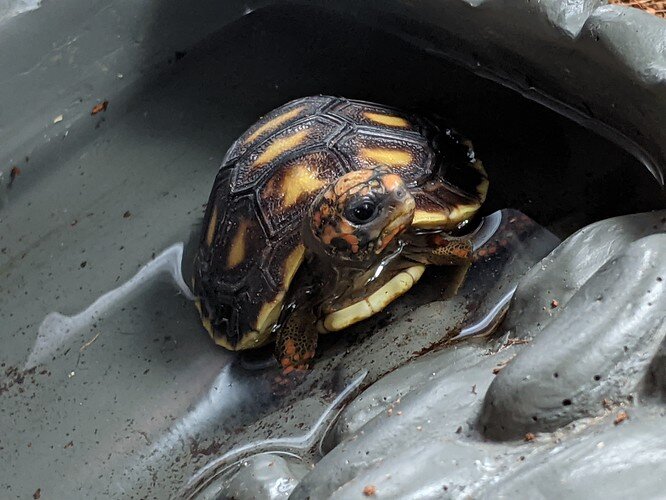Recently, I came across another rescue situation, a young lady with another space and moving crisis asked for help with… Atlas. She told me at one point Atlas was a purchase made at an expo, through LLL Reptiles, some may be familiar with the company, but she was sold as a Grenada Island Red Foot, and I don’t have much info past that, hatch date or anything, she stopped communicating with me after a couple of days following my correspondence about the changes I made for Atlas and her enclosure, which she came with, and I outfitted to better suit her, I think because she’s satisfied that Atlas found a good home but couldn’t answer my questions about her purchase info. Since we have access to this wonderful plethora of information, I wanted to bring this to here, and because I know we have several people here that are more than experienced with this species, and other locales of the species, to assist with positive identification, if possible, and to explain some about things like sexing a tortoise, and some basics about their care, diet, etc. I’ll bullet point the subjects I’ve been looking through and trying to research, with very limited specific information on this species, and if she’s a Grenada Island Red Foot, any pertinent information about the species in comparison to the other locales, such as the smaller Cherry Head Red Foot from Brazil. Now, I’ve never kept a tortoise before, although I’ve always wanted to, since I was a little kid, they’ve always fascinated me, and although I have a lot of experience with many other types of reptiles, this is a totally new experience for me, and I’ve done a lot of research on the care and such of Red Foots for a while, especially here more recently because of the MRC, which gave me a pretty good help with a head start, regarding taking her on and management of her health and environment. HOWEVER. That being said, I think I can count on one hand the threads we have available here with wholesome information about some of the questions I had about them, some of which I feel are fairly basic for someone who’s never had a turtle or a tortoise before. And the rest of the internet is very hit or miss, forums about just tortoises for example are very convoluted, or opinionated, and one of the reasons I like the MRC enough to be on here every single day, is that it allows us to very cleanly, and with good representation by our members, teach and distribute good open source info, and I hope between my own curiosity, and the lack of information I was able to collect, we can do a better job here. Anyway, my bullet points are as follows:
-
Habitat Needs and Recommendations, Do’s and Dont’s (in regards to indoor keeping), such as substrate requirements and different environmental needs such as plants, soil types, woods, hide needs etc.
-
Dietary Needs and Recommendations, such as what kinds of foods they eat regularly, what foods they eat based on preference, what supplements (Calcium/D3 for instance) should be used, or not, and why. Most convoluted subject I’ve seen so far about them.
-
Lighting, Heating and Humidity Needs and Recommendations, such as what temperatures and humidity levels are acceptable, what temperatures/humidity levels they thrive in and breed well in best, what type of lights/heating elements need to be used, etc.
-
Basic Interaction Info and Suggestions and Social Needs, such as how to approach and befriend your tortoise, if you’re a beginner, and how they tend to interact with their people, and other tortoises.
-
Basic Locale Differentials and Explanations, such as size, health, age and husbandry differences and info between the locales, what applies anyway.
-
This is the MOST important, in my opinion, and was, aside from dietary, the least covered subject I was able to research. Specific information on Hatchlings, Juveniles, and what, if any, specific needs they had, as opposed to adults. And breeding information, such as age of maturity, mating seasons and circumstances, clutch collection and incubation, etc.
Anyway, without further ado, here’s Atlas!





